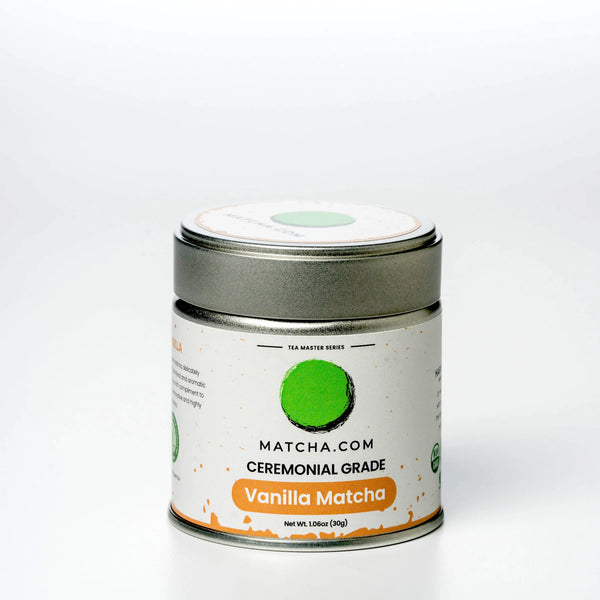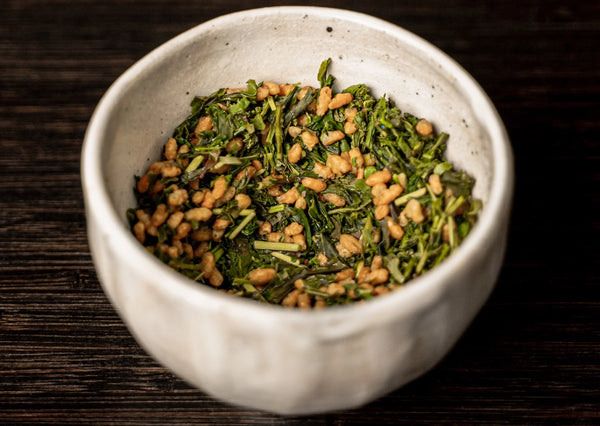Traditional Japanese matcha has a deep flavor profile. It’s vegetal and grassy, nutty, sweet and umami. When made with care and attention to maintaining quality, flavored matcha will bring you all the tastes of traditional matcha with a delicious and healthy twist! 
Making flavored matcha
We craft our organic ceremonial-grade flavored matcha with just two ingredients - certified organic matcha and real fruit essence. With no added sugar, you can enjoy a new flavor profile in your matcha and maintain all the health benefits of traditional, non-flavored matcha. Our matcha flavors come directly from Japan and use either mango, vanilla bean, or chocolate essence. Our Tea Masters perfected our recipe so that our tins of flavored matcha give you the ideal balance of mango, vanilla, or chocolate flavor that compliments the rich umami taste that high-quality matcha is known for.
It’s important to note that our matcha flavors have zero added sugar or harmful ingredients - that means no negative health effects, just delicious flavored matcha! Even the most strict of matcha purists love our matcha flavors.
Mango matcha 
Pop open a tin of our ceremonial-grade mango-flavored matcha, and you’ll instantly be hit with the delicious zing of aromatic mango. We chose mango because its fruity, tropical flavor complements the sweet, grassy flavors of matcha perfectly, and the health benefits of mango are outstanding.
Mango essence is high in vitamins A & C and beta-carotene. Mangos are anti-inflammatory and anti-aging and help fight free radicals. Combine the health benefits of mango with matcha, and voila, you’ve got a delicious superfood drink!
There are so many tasty recipes you can make using our mango matcha flavor. Stick to a more traditional drink like a mango matcha latte, or go wild and try our summer glow smoothie and pair your mango-flavored matcha with real mango fruit for a bold kick of flavor and tons of vitamins. If you want to satisfy your sweet tooth, use our mango matcha powder and follow this matcha macaron with mango buttercream recipe. Trust us, your friends will be convinced you’re a bake-off star.
Vanilla matcha 
It’s easy to understand why we’d choose to combine real, natural vanilla bean essence with matcha. Just the sound of it - vanilla matcha - will make your mouth water. But aside from the tried and true combination of vanilla essence and earthy flavors, we also chose vanilla for its health benefits.
The health benefits of vanilla are often overlooked. Vanilla is scientifically proven to have a calming effect on both babies and adults! It can reduce our startle reflexes and provide relief from bloating and sleep apnea. Vanilla can also curb our sugar cravings and, combined with green tea, can lead to weight loss.
Our vanilla-flavored matcha has floral and aromatic notes and pairs perfectly with earthy, umami-flavored matcha. It’s the ideal combination of savory and sweet flavors without any added sugar. Make a relaxing vegan vanilla matcha latte, or add our vanilla matcha to any matcha-centric recipe like this dairy-free matcha ice cream cake for a delicious take on your favorites.
Chocolate matcha 
Chocolate or vanilla? The age-old question that can divide a birthday party in two. Our chocolate-flavored matcha is for all those die-hard chocolate lovers out there (and the ones who just dabble, too). Blending chocolate essence with our ceremonial grade matcha was a combination we couldn't resist.
Chocolate essence is the perfect way to get a rich, natural, sweetened flavor into your matcha without using added or artificial sweeteners. Our chocolate matcha flavor brings a creamy, full-bodied taste to your matcha that coats your tongue and melts in your mouth.
Chocolate essence is made from cocoa and boasts health benefits that can improve cardiovascular and cognitive functions and tastes so good you can practically add it to anything.
There are so many delicious matcha recipes that benefit from chocolate-flavored matcha that it’s hard to narrow down our favorites! Add our chocolate-flavored matcha to Hojicha hot chocolate, chocolate cupcake with matcha buttercream, or matcha fudge, and get ready to have your taste buds rocked.
Matcha Genmaicha
If you’re looking to try another take on traditional matcha that’s a bit different than our mango, vanilla, and chocolate flavored matcha, try matcha genmaicha.
This blend of matcha and toasted brown rice powder boasts powerful health benefits, lower caffeine content, and a delicious roasted nutty flavor + all the flavors of matcha that make it a cost-effective way to get a more full-bodied drink than a traditional cup of tea.
The bottom line
There are a lot of options out there for flavored matcha, but few can stand up to the quality and limited ingredients of ours. Chocolate, vanilla and, mango flavored matcha are all unique, delicious, healthy, and worth trying!
Disclaimer: These statements in this blog post have not been evaluated by the Food and Drug Administration. The information provided here is for educational purposes only and should not be considered medical advice. It's essential to consult with a qualified healthcare professional before making any dietary or lifestyle changes.
References:
Lauricella, M., Emanuele, S., Calvaruso, G., Giuliano, M., & D'Anneo, A. (2017). Multifaceted Health Benefits of Mangifera indica L. (Mango): The Inestimable Value of Orchards Recently Planted in Sicilian Rural Areas. Nutrients, 9(5), 525. https://doi.org/10.3390/nu9050525
Shyamala, B. N., Naidu, M. M., Sulochanamma, G., & Srinivas, P. (2007). Studies on the antioxidant activities of natural vanilla extract and its constituent compounds through in vitro models. Journal of agricultural and food chemistry, 55(19), 7738–7743. https://doi.org/10.1021/jf071349+
Katz, D. L., Doughty, K., & Ali, A. (2011). Cocoa and chocolate in human health and disease. Antioxidants & redox signaling, 15(10), 2779–2811. https://doi.org/10.1089/ars.2010.3697







